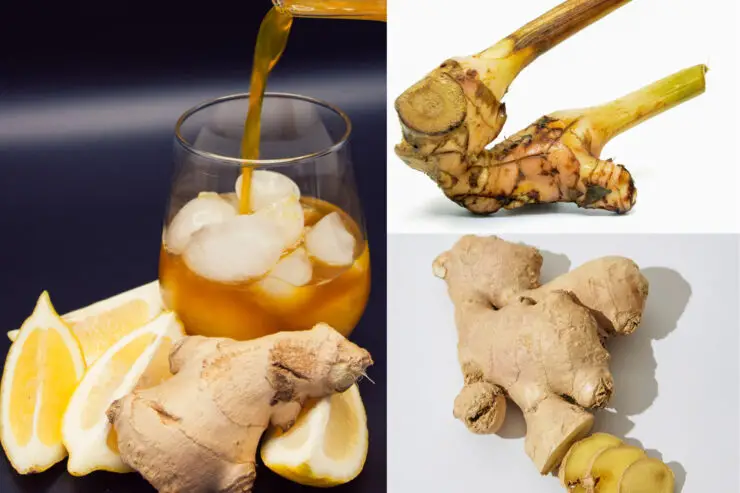As an Amazon Associate I earn from qualifying purchases. Please read the disclaimer for more info.
Galangal vs. ginger. Two aromatic and versatile spices that have been used for centuries in Asia for culinary and medicinal purposes.
While they look fairly similar, they also share some key differences, which are why you should know the difference between galangal and ginger before you use them in a recipe.
Do they taste the same? Is there a difference in the preparation? What’s the best way to store them?
Let’s take a closer look at these two spices and find out!
Galangal vs. Ginger: Similarities and Differences
Galangal and Ginger are both in the Zingiberaceae family. Commonly known as the ginger family, it is a family of flowering plants comprising more than 1300 species of aromatic perennial herbs with tuberous rhizomes, a kind of plant that grows underground and sends out shoots to make new plants.
These plants grow in moist areas of the tropics and subtropics, including some seasonably dry regions. Apart from ginger and galangal, other spices in the ginger family include turmeric, cardamom, melegueta pepper, and myoga.
Ginger and Galangal are used in many countries’ cuisines, including China, Cambodia, Thailand, Indonesia, Malaysia, Vietnam, Singapore, and Laos. Galangal is widely used in Thai cuisine and Thai cooking.
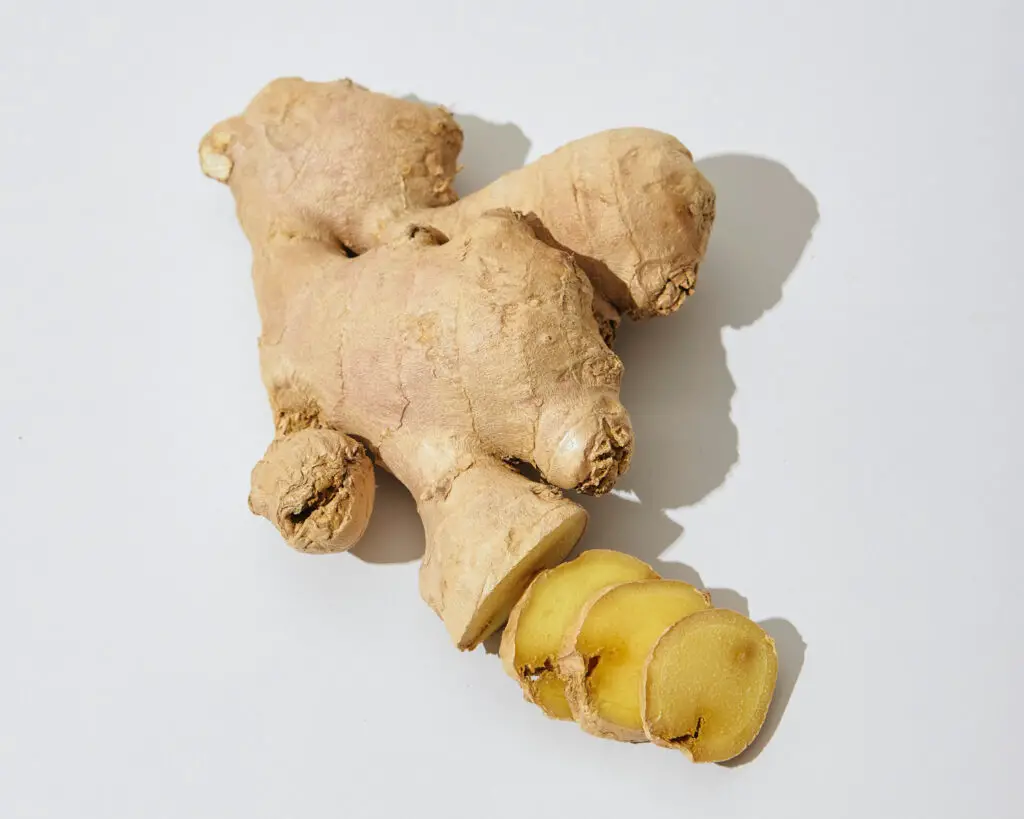
Galangal and ginger can resemble each other in external appearance. They both have a similar irregular shape and have hardened rhizomes. However, texture differs in that galangal has a smoother and lighter skin, whereas ginger is darker with a considerably harder feel.
The biggest difference is in taste. While galangal has tones of pepper and is quite piquant and sharp in flavor, ginger has a sweet and spicy palate. Galangal is a bit spicier than ginger and has a more floral aroma.
There are three varieties of galangal. Lesser galangal, greater galangal, and light galangal. Lesser galangal originated in China, has a more peppery bite, and is easiest to cultivate. Greater galangal grows in Indonesia and has a milder flavor. Light galangal comes from India and has a closer taste to ginger.
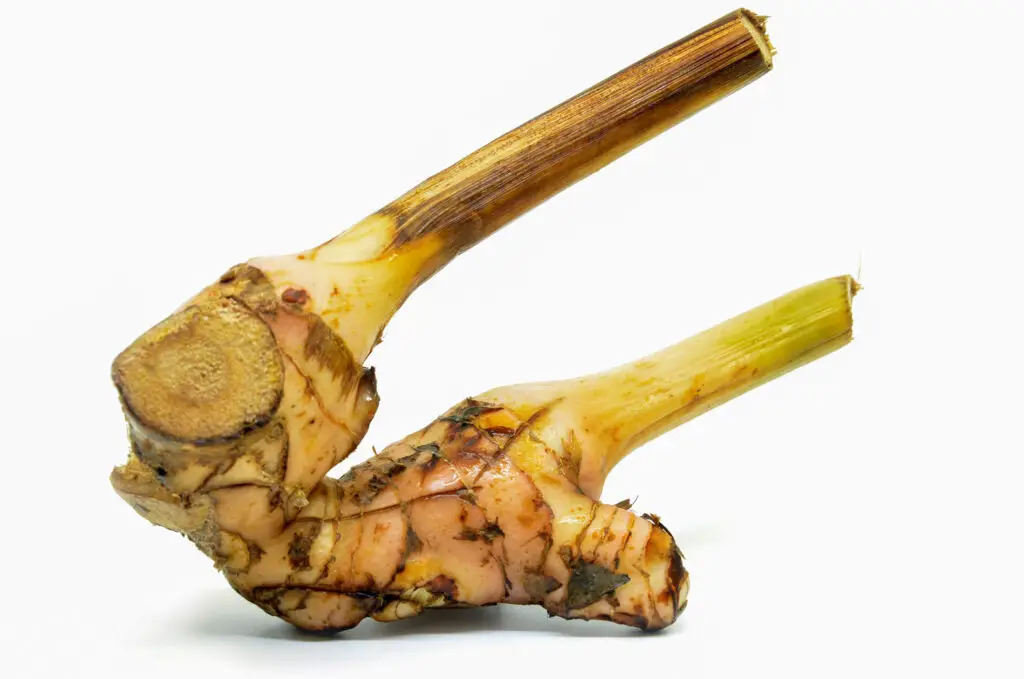
These spicy ingredients are interchangeable in some recipes, although serving sizes generally need to be altered to taste.
They share a long history of use in Ayurvedic medicine and Thai and Chinese herbal medicine.
Both have ground powders that are sold widely for culinary and medicinal purposes.
Culinary uses of Galangal and Ginger
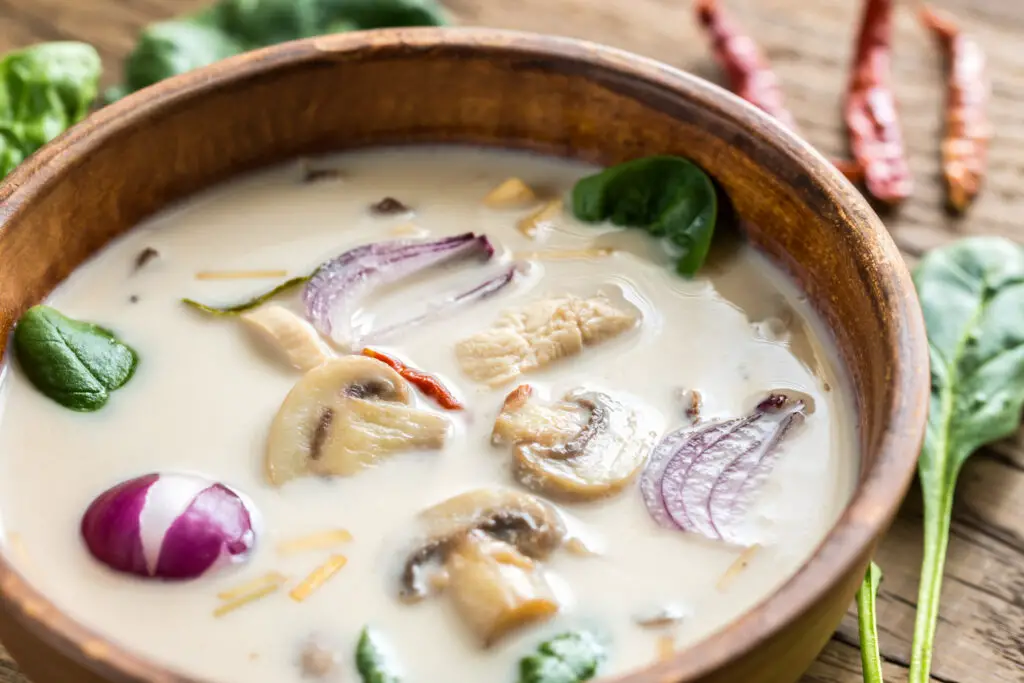
Both galangal and ginger are versatile spices that can be used in various dishes. Add them to soups, curries, curry pastes, salad dressings, marinades, or even a pasta dish. You can also steep them in hot water to make tea.
Both galangal and ginger can be fresh or powdered.
Preparation: Galangal vs. Ginger
Fresh galangal needs to be peeled, and the skin can be quite tough, so use a sharp knife. The flesh is then grated or sliced finely. Powdered galangal can also be used and is convenient to keep on hand in its powdered form as it lasts for a long time.
The skin of fresh ginger is much softer than galangal and can be removed easily with a spoon. The ginger is then grated or sliced finely. Powdered ginger is also convenient to keep on hand and has a long shelf life, as does galangal powder.
Ginger and Galangal are used in many Asian cuisines and are great for adding spice to cooking. Galangal is primarily used in Thai food, although they both can be used in Chinese, Vietnamese, Thai, Malaysian, Indonesian, and Indian cooking alongside other Southeast Asia recipes.
Here are a few food and drink recipe ideas to step-up your cooking.
Sautéed Ginger Beef
This quick and easy beef dish is perfect for a weeknight meal. The beef is stir-fried with onions, ginger, and garlic until cooked. Serve over steamed rice or noodles.
Hot and Sour Soup
This classic soup is made with chicken stock, tofu, bamboo shoots, mushrooms, and eggs. The soup gets its characteristic sour flavor from adding vinegar and soy sauce, while the ginger lends itself to a peppery taste.
Thai Green Curry with Chicken
This delicious Thai cuisine classic curry features chicken, green bell peppers, coconut milk, and Thai green curry paste. The curry paste contains galangal, also called Thai ginger or Siamese ginger, with a nice spicy flavor.
Asian Salad with Sesame Ginger Dressing
This salad is light and refreshing with edamame, lettuce, cabbage, carrots, almonds, and orange pieces mixed and combined with a dressing that has a zesty, citrusy, and slightly sweet taste.
Malaysian Spiced Pork Stew
This pork stew is cooked in a Malaysian spice paste that contains galangal. The stew is served over steamed rice.
Ginger Tea
This tea is perfect for when you’re feeling sick or have a cold. It’s made with fresh ginger root, honey, and lemon juice.
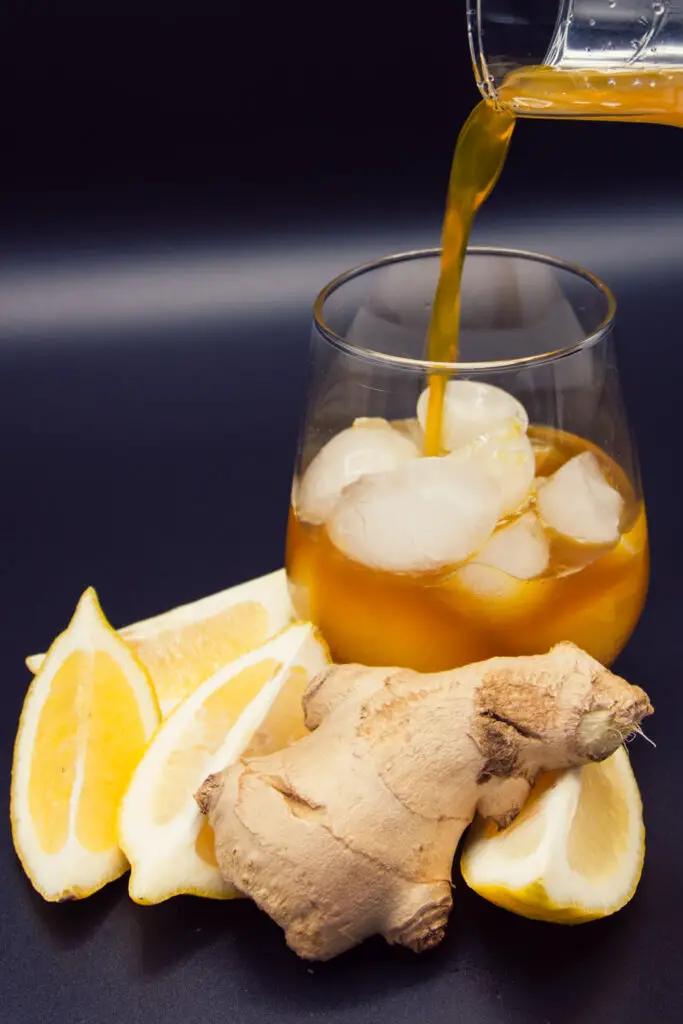
Tips for buying and storing Ginger and Galangal
- When buying ginger root, look for firm, fresh pieces with smooth outer skin. If you see wrinkles, it’s already beginning to deteriorate.
- Galangal roots should also be firm, with a bright, somewhat unblemished surface. Slightly papery rings on the outside are normal.
- As ginger and galangal are rhizomes, they are likely to be sold with cut ends. These may be dried out but shouldn’t be soft or moody.
- Galangal can be stored in the refrigerator for up to two weeks.
- Ginger is best stored in the refrigerator with the peel on and can be kept for up to two months.
- If you’re not going to use them immediately, you can freeze ginger and galangal. The best method is to peel and chop them into small pieces, place into an airtight container or bag, and freeze them for up to six months.
- Ground ginger and dried ginger stored in containers with air-tight lids will generally last three years.
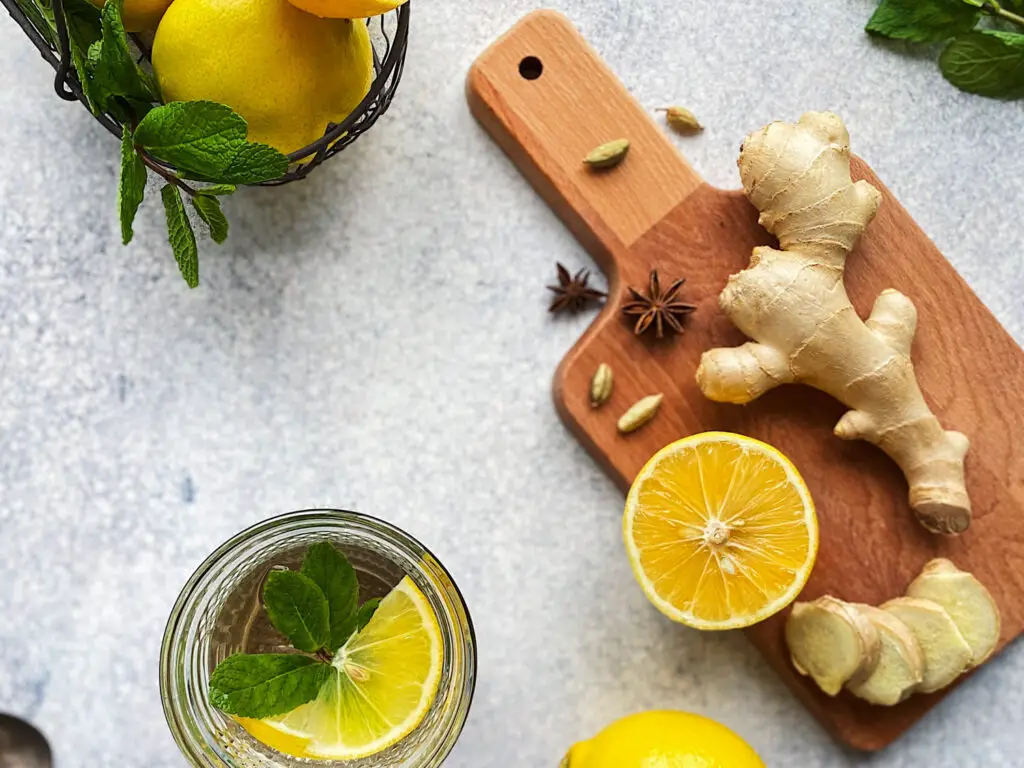
Health benefits of Galangal and Ginger
Both are packed with health benefits. The main bioactive compound in ginger is called gingerol, and the galangal root’s active compound is known as galangin.
Ginger helps to reduce symptoms such as nausea and vomiting well as helping to reduce swollen joints. Ginger also has shoagol, a substance with an analgesic effect that also helps against cancer and heart disease. Zingiberene in ginger is particularly good for digestion.
Let’s explore some health benefits.
Both are high in Antioxidants
Both galangal and ginger are especially rich in polyphenols, a group of antioxidants linked to health benefits such as improved memory, lower LDL cholesterol levels, and lower blood sugar, as well as protection against type 2 diabetes and heart disease.
May Have Cancer Fighting Properties
Galangal may assist protect your body against certain types of cancer. Some studies suggest that galangin, the active compound in galangal root, may have some anti-cancer effects on several different cancers, including liver cancer, and melanoma, with a suggestion it could kill strains of human colon cancer cells.
Galangal Root can Improve Male Fertility
Galangal can help improve fertility by increasing the number of healthy sperm. A study on rats concluded that applying an extract of galanga increased sperm percentage, viability, motility, and testosterone hormone.
Anti-Inflammatory and Anti-fungal Properties
Both ginger and galangal have anti-inflammatory properties that can help to reduce inflammation in the body. This can be especially helpful for arthritis, asthma, knee pain, and skin problems. It can also reduce muscle pain and elevate energy levels. And both have anti-fungal properties that can help to reduce the growth of fungus in the body. This can be especially helpful for conditions like athlete’s foot, yeast infections, and oral thrush.
Ginger Appears to be an Effective Remedy Against Nausea
Ginger products, including, tea, ginger beer, and ginger extract, have shown to be effective in pregnancy-related nausea, such as morning sickness, and helping soothe an upset stomach. They may help ease nausea for those undergoing surgery, but further studies are needed.
May Help with Weight Loss
Ginger may stimulate several biological activities in your body leading to reduced hunger, and faster digestion of food, and may help the body to speed digested food through the colon. Related reading here.
So if you’re looking for a way to add some flavor while tackling various ailments and health benefits while cooking your next Asian dish, be sure to add either of these two rhizomes!
Galangal vs. Ginger. The Conclusion
Both have a long history of use in Asia with culinary and medicinal uses. Galangal has a spicier and more peppery flavor, with both being excellent for cooking. When buying ginger or galangal root, look for firm pieces with a bright exterior that isn’t too wrinkled. Finding galangal may be more challenging, but given the difference between galangal and ginger, the hunt for the pungent member of the same family will be worth it.
Just remember not to be confused by the similar appearance.
FAQ for Galangal vs. Ginger
Can I substitute fresh ginger for powdered Ginger?
Yes, as they are in the same family, you can substitute fresh ginger for powdered. One tablespoon of fresh ginger is equivalent to one teaspoon of powdered ginger.
Can I substitute galangal for ginger?
Yes, you can use galangal as a substitute for ginger. Remember that it’s a little spicier than ginger, so you may want to use less of it in your favorite Thai dishes.
What are Some Substitutes for Ginger?
If you are making a hearty stew, then apart from Galangal, Allspice will add the peppery taste and is a great substitution. Cardamom will add sweet, spicy, and citrusy flavors to dishes and drinks. Turmeric is an excellent addition to rice dishes, soups, and smoothies, while Cinnamon and Nutmeg are sweet and woody, making them good swaps for ginger, especially in custards, cakes, and pies.
What are Some Substitutes for Galangal?
The perfect galangal substitute in seafood dishes is Fingerroot due to the milder aroma. Lemongrass is an excellent addition to stews and soups because of the mild spiced-citrus flavor. Lemongrass is edible when finely chopped and great in stir-fries. Turmeric is another good substitute, mainly in stews, curries, and curry pastes, as the flavor can be too bitter in dishes like stir-fries.
Are Thai Ginger or Siamese Ginger part of the Ginger Family?
Yes, these are sometimes used as names instead of galangal as ingredients in Thai cooking.
Where can I find Galangal?
International and Asian markets tend to stock galangal. It is not a common ingredient in supermarkets.

